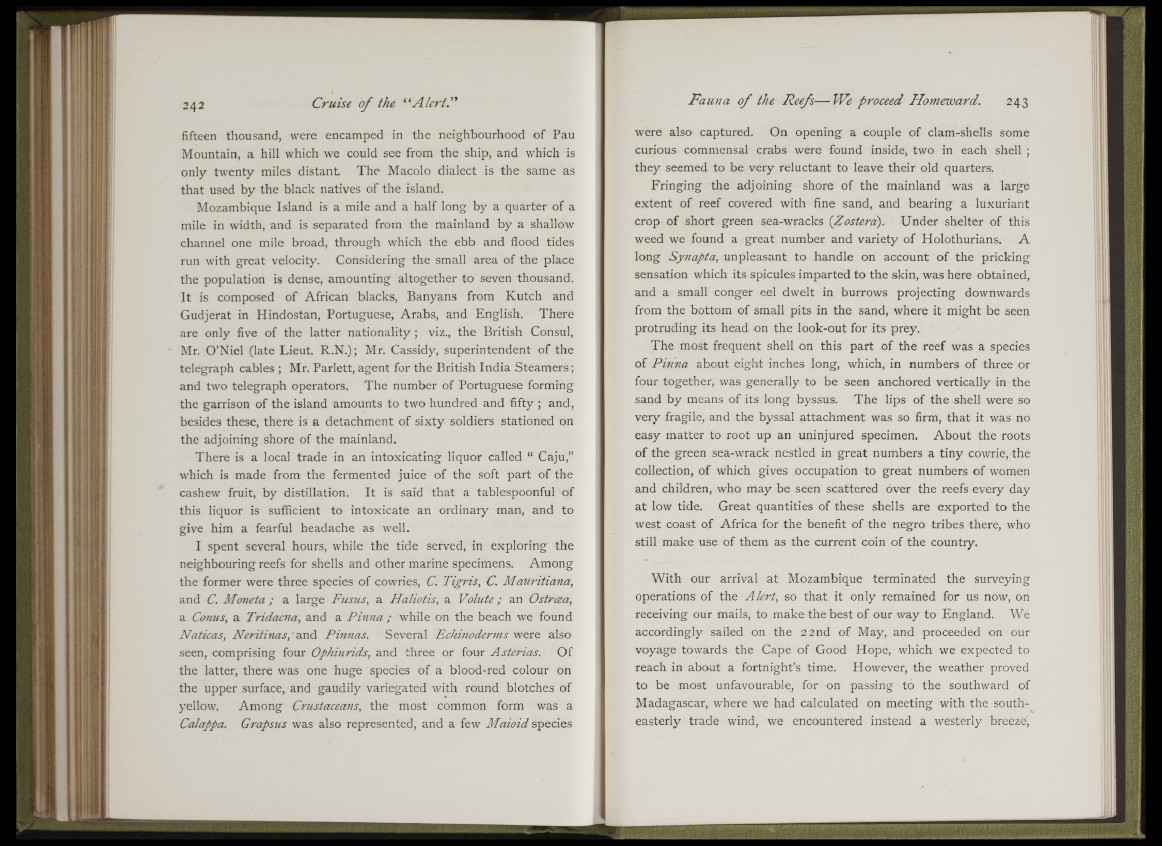
...
fifteen thousand, were encamped in the neighbourhood of Pau
Mountain, a hill which we could see from the ship, and which is
only twenty miles distant The Macolo dialect is the same as
that used by the black natives of the island.
hlozambique Island is a mile and a half long by a quarter of a
mile in width, and is separated from the mainland by a shallow
channel one mile broad, through which the ebb and fiood tides
run with great velocity. Considering the small area of the place
the population is dense, amounting altogether to seven thousand.
It is composed of African blacks. Banyans from Kutch and
Gudjerat in Hindostán, Portuguese, Arabs, and English. There
are only five of the latter nationality ; viz., the British Consul,
Mr. O’Niel (late Lieut. R.N.); Mr. Cassidy, superintendent of the
telegraph cables ; Mr. Parlett, agent for the British India Steamers;
and two telegraph operators. The number of Portuguese forming
the garrison of the island amounts to two hundred and fifty ; and,
besides these, there is a detachment of sixty soldiers stationed on
the adjoining shore of the mainland.
There is a local trade in an intoxicating liquor called “ Caju,”
which is made from the fermented juice of the soft part of the
cashew fruit, by distillation. It is said that a tablespoonful of
this liquor is sufficient to intoxicate an ordinary man, and to
give him a fearful headache as well.
I spent several hours, while the tide served, in exploring the
neighbouring reefs for shells and other marine specimens. Among
the former were three species of cowries, C. Tigris, C. Mauritiana,
and C. Moneta; a large Tusus, a Haliotis, a Volute; an Ostrcea,
a Conus, a Tridacna, and a Pinna ; while on the beach we found
Naticas, Neritinas, ' z.r\á Pinnas. Several Echinodernis were also
seen, comprising four Ophiurids, and three or four Asterias. Of
the latter, there was one huge species of a blood-red colour on
the upper surface, and gaudily variegated with round blotches of
yellow. Among Crustaceans, the most common form was a
Calappa. Grapsus was also represented, and a few Maioid
Fauna o f the Reefs— We proceed Homeward. 243
were also captured. On opening a couple of clam-shells some
curious commensal crabs were found inside, two in each shell ;
they seemed to be very reluctant to leave their old quarters.
Fringing the adjoining shore of the mainland was a large
extent of reef covered with fine sand, and bearing a luxuriant
crop of short green sea-wracks (Zostera). Under shelter of this
weed we found a great number and variety of Holothurians, A
long Synapta, unpleasant to handle on account of the pricking
sensation which its spicules imparted to the skin, was here obtained,
and a small conger eel dwelt in burrows projecting downwards
from the bottom of small pits in the sand, where it might be seen
protruding its head on the look-out for its prey.
The most frequent shell on this part of the reef was a species
of Pinna about eight inches long, which, in numbers of three or
four together, was generally to be seen anchored vertically in the
sand by means of its long byssus. The lips of the shell were so
very fragile, and the byssal attachment wa.s so firm, that it was no
easy matter to root up an uninjured specimen. About the roots
of the green sea-wrack nestled in great numbers a tiny cowrie, the
collection, of which gives occupation to great numbers of women
and children, who may be seen scattered over the reefs every day
at low tide. Great quantities of these shells are exported to the
west coast of Africa for the benefit of the negro tribes there, who
still make use of them as the current coin of the country.
With our arrival at Mozambique terminated the surveying
operations of the Alert, so that it only remained for us now, on
receiving our mails, to make the best of our way to England. We
accordingly sailed on the 22nd of May, and proceeded on our
voyage towards the Cape of Good Hope, which we expected to
reach in about a fortnight’s time. However, the weather proved
to be most unfavourable, for on passing to the southward of
Madagascar, where we had calculated on meeting with the southeasterly
trade wind, we encountered instead a westerly breeze.